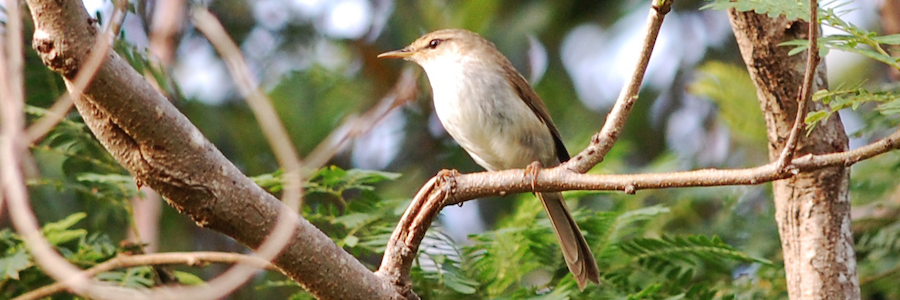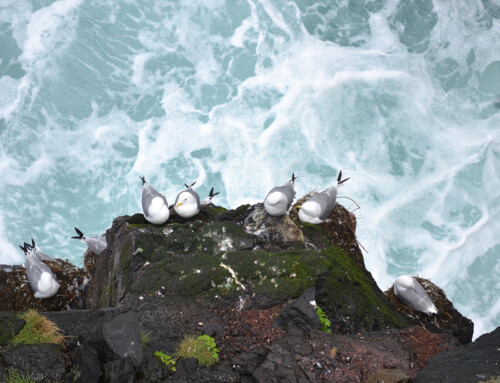Report from a BOU-funded project
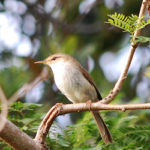 Like other bush warblers, Japanese bush warblers often hide in shrubs and are therefore not easily sighted. However, if you are an anime fan, you may have heard their songs. These bush warblers sing loudly and regularly during the breeding season, and their songs are therefore often featured in many Japanese anime as a way of indicating the arrival of spring. However, some mysteries remain regarding the taxonomy of the Japanese bush warbler complex (Horornis diphone/canturians).
Like other bush warblers, Japanese bush warblers often hide in shrubs and are therefore not easily sighted. However, if you are an anime fan, you may have heard their songs. These bush warblers sing loudly and regularly during the breeding season, and their songs are therefore often featured in many Japanese anime as a way of indicating the arrival of spring. However, some mysteries remain regarding the taxonomy of the Japanese bush warbler complex (Horornis diphone/canturians).
The Japanese bush warbler (Horornis diphone/canturians) complex includes six subspecies, namely diphone, cantans, restrictus, riukiuensis, canturians and borealis (Kennerley and Pearson 2010). The former four subspecies breed mainly in the Japanese archipelago, while the latter two subspecies breed mainly in China and the Korean peninsula (Fig. 1). The two Asian mainland races are usually grouped under a separate species name, Manchurian bush warbler Horonis canturians, due to their significantly larger body size and more reddish-coloured plumage.
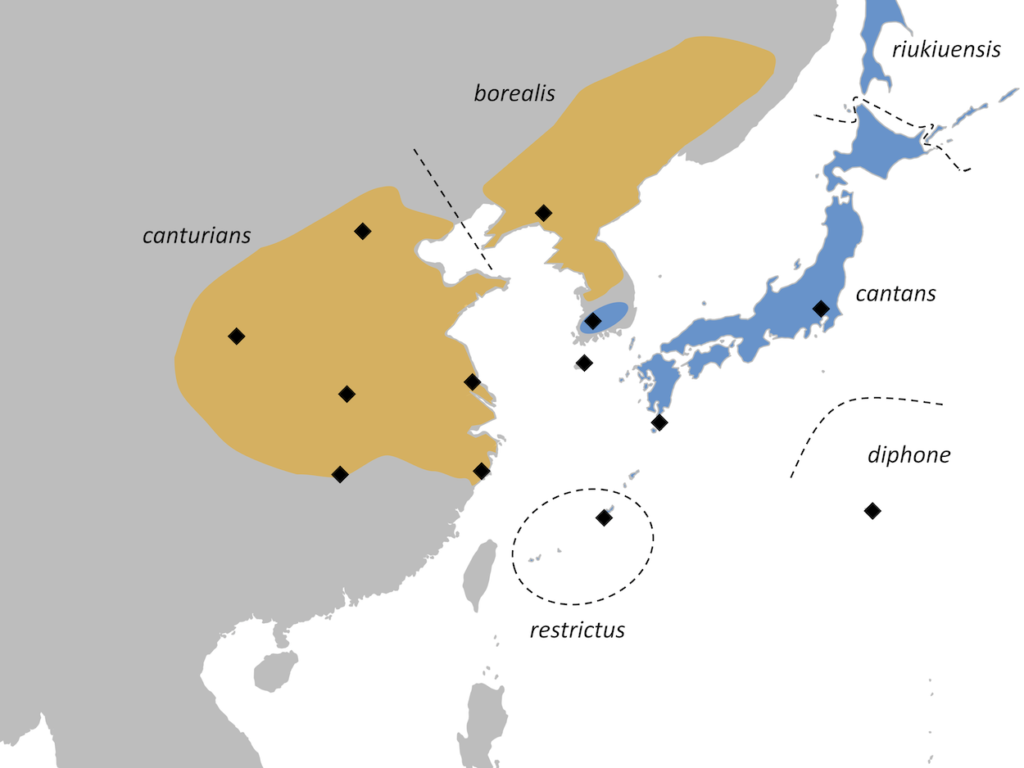 Figure 1 Map of breeding distribution of taxa of the Japanese bush warbler complex. DNA sampling sites in the current study are shown.
Figure 1 Map of breeding distribution of taxa of the Japanese bush warbler complex. DNA sampling sites in the current study are shown.
Within the Japanese races, significant morphological divergence (Fig. 2) was revealed in a previous study (Kajita 2002). The author showed that the birds of the nominate race, i.e. H. d. diphone, are significantly smaller than other Japanese races (Fig. 2). The nominate race only breeds on some small and remote islands south of the major islands (i.e. the Izu Islands, Ogasawara Islands and Iwo Islands) of the Japanese archipelago. Such significant morphological divergence therefore posed the question of whether these populations should be treated as a distinct species. Kajita (2002) provided the first and preliminary answer by showing a mitochondrial cyt b phylogeny that the genetic divergence between the nominate race and the other subspecies of Japanese bush warbler was rather shallow. This could mean that the H. d. diphone represent a case of a rapid morphological evolution after an island colonization event. However, since the study only used one mitochondrial gene, it is also possible that the birds of the nominate race are actually a long-diverged species that underwent a mitochondrial introgression event (Funk and Omland 2003), i.e. they acquired cyt b alleles from other Japanese races more recently. This is an important question to ask as these birds only breed in a group of remote small islands and their population size is likely to be very small. If they prove to be a distinct species, raising their conservation status is a matter of urgency, as they may be prone to extinction due to potential environmental perturbation.
 Figure 2 Morphological divergence between different taxa of the Japanese bush warbler complex. Modified from Kajita 2002.
Figure 2 Morphological divergence between different taxa of the Japanese bush warbler complex. Modified from Kajita 2002.
Beside the mystery of the taxonomic status of the nominate race, there are also some controversies around the two mainland taxa (Fig. 1). Although most researchers consider the two mainland races canturians and borealis as one species, there are some different opinions. For instance, some authors placed borealis as a member of Japanese bush warbler (Zheng, 2011). On the other hand, in a recently published phylogenetic study, the authors suggested that canturians belongs to the H. diphone clade (i.e. to be grouped with Japanese races), while the subspecies borealis should be treated as monotypic species (Alström et al., 2011). However, as the study only used one sample of canturians, the result may not be conclusive.
In the current study, a team with researchers from China, Japan and Sweden applied an integrative taxonomic approach, with a more comprehensive sampling scheme, to tackle the afore-mentioned problems. The multilocus phylogenetic relationship of the Japanese bush warbler complex was reconstructed and the divergence times between different taxa were estimated. The researchers also investigated the song divergence between these taxa in order to better understand the taxonomy.
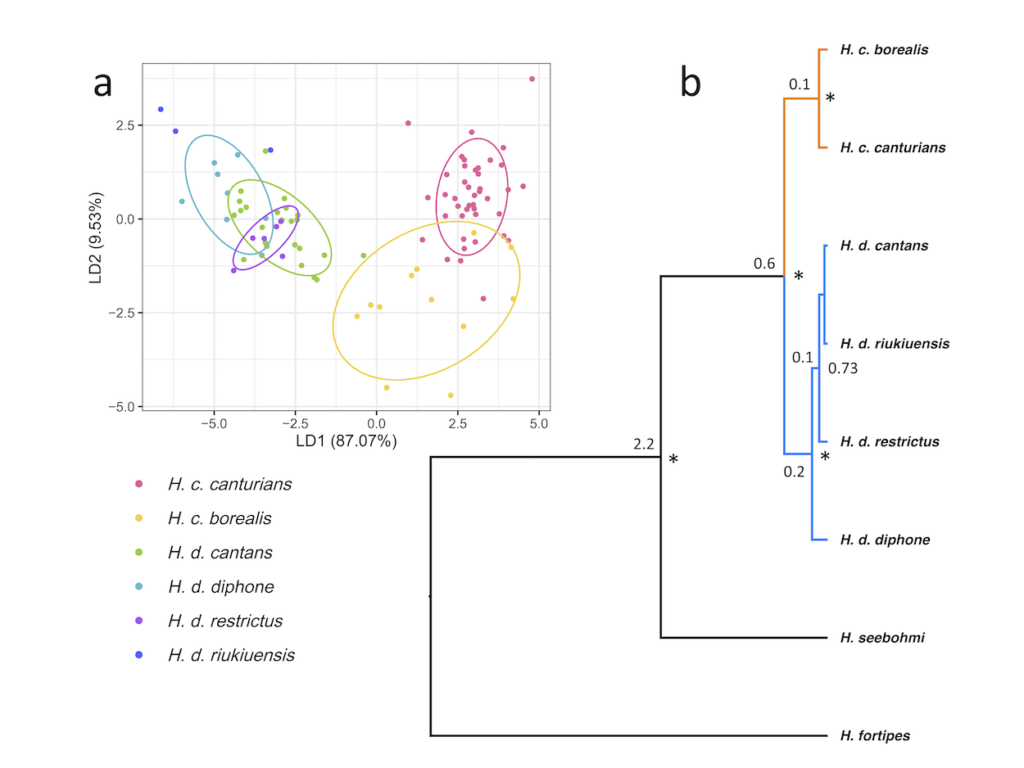 Figure 3 (a) Linear Discriminant Analysis of songs of the H. diphone/canturians complex. (b) Phylogenetic relationship of the Horornis diphone/canturians complex, reconstructed with *BEAST method. The divergence times are shown on the left side of the nodes, and the posterior probabilities (PP) are shown on the right side of the nodes, and PP ≥ 0.99 are indicated with asterisks.
Figure 3 (a) Linear Discriminant Analysis of songs of the H. diphone/canturians complex. (b) Phylogenetic relationship of the Horornis diphone/canturians complex, reconstructed with *BEAST method. The divergence times are shown on the left side of the nodes, and the posterior probabilities (PP) are shown on the right side of the nodes, and PP ≥ 0.99 are indicated with asterisks.
Rapid morphological evolution during island colonization
Contrary to their prediction, and despite being morphologically distinct, the nominate race H. d. diphone actually diverged from other H. diphone races very recently. The multilocus molecular dating suggested a divergence time of around 0.2 million years ago (Fig. 3b). Although the phylogenetic result is more or less consistent with the previous study (Kajita 2002), the current study confirmed that the populations from those remote islands represent a recent colonization event and experienced a rapid morphological evolution within a relatively short time period. This is somewhat surprising as the morphometrics are generally considered to be more conserved due to niche conservatism (Wiens et al. 2010, Winger and Bates 2015). This observation is also interesting as it could represent a case of the “island rule”, that is, in this case, occurrence of island dwarfism due to certain eco-evo processes happened during colonization (Lomolino 2005). Due to its relatively young divergence, and its rather similar song compared to other subspecies of Japanese bush warblers (Fig. 3a), we suggest that this taxa should still be placed under the name H. diphone. On the other hand, we consider the nominate race should be treated as an evolutionary significant unit (Moritz 1994) and more conservation awareness is needed.
Phylogenetics and acoustic data support the Japanese/mainland Asian split
The phylogenetic analysis suggests that the complex divided into two well supported clades, i.e. the Japanese clade (H. d. cantans, H. d. diphone, H. d. restricta, H. d. riukiuensis) and the mainland Asian clade (H. c. borealis and H. c. canturians) (Fig. 3b). Similarly, the song divergence pattern is consistent with the phylogenetic pattern, with the two mainland Asian races being distinct from Japanese races (Fig. 3a). All this evidence suggested that the more widely accepted taxonomic treatment of Japanese/mainland Asia split is appropriate. The result of the previous study could come from a mislabelling of the sample, or using a hybrid individual.
Funding
Chentao Wei (Postdoc, Sun Yan-sen University, China) was awarded a small ornithological grant of £1,000 in 2018 for a project entitled ‘Phylogeography and integrative taxonomy of Japanese bush warbler complex sensu lato Horornis diphone/canturians’.
References
Alström, P., Höhna, S., Gelang, M., Ericson, P.G.P., Olsson, U. 2011. Non-monophyly and intricate morphological evolution within the avian family Cettiidae revealed by multilocus analysis of a taxonomically densely sampled dataset. BMC Evolutionary Biology 11: 352.VIEW
Funk, D.J. & Omland, K.E. 2003. Species-level paraphyly and polyphyly: frequency, causes, and consequences, with insights from animal mitochondrial DNA. Annual Review of Ecology, Evolution, and Systematics 34: 397–423.VIEW
Kajita, M. 2002. Intra-specific phylogeography in Cettia diphone. Iden 56: 42–46.
Kennerley, P. & Pearson, D. 2010. Reed and bush warblers A&C Black.
Lomolino, M.V. 2005. Body size evolution in insular vertebrates: generality of the island rule. Journal of Biogeography 32: 1683–1699.VIEW
Moritz, C. 1994. Defining ‘evolutionarily significant units’ for conservation. Trends in Ecology & Evolution 9: 373–375.VIEW
Wiens, J.J., Ackerly, D.D., Allen, A.P., Anacker, B.L., Buckley, L.B., Cornell, H.V., Damschen, E.I., Davies, T.J., Grytnes, J. & Harrison, S.P. 2010. Niche conservatism as an emerging principle in ecology and conservation biology. Ecology Letters 13: 1310–1324.VIEW
Winger, B.M. & Bates, J.M. 2015. The tempo of trait divergence in geographic isolation: Avian speciation across the Marañon Valley of Peru. Evolution 69: 772-787.VIEW
Zheng 2017. A Checklist on the Classification and Distribution of the Birds of China. 3rd edition Science Press, Beijing.
Image credit
Top right: Japanese bush warbler nominate race Horornis diphone diphone © Isao Nishiumi



